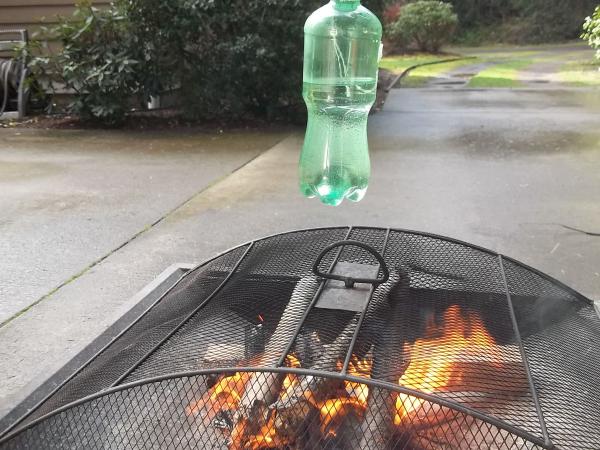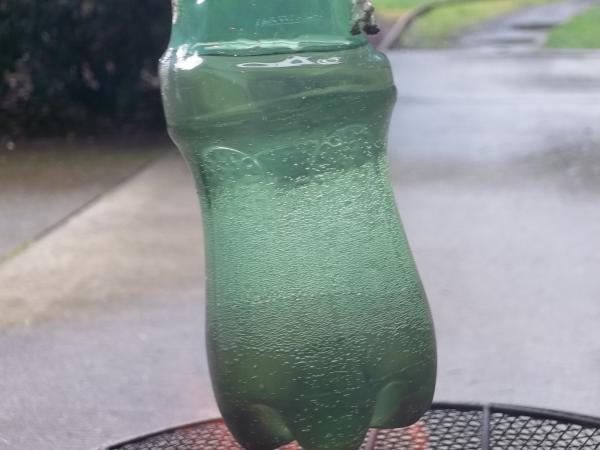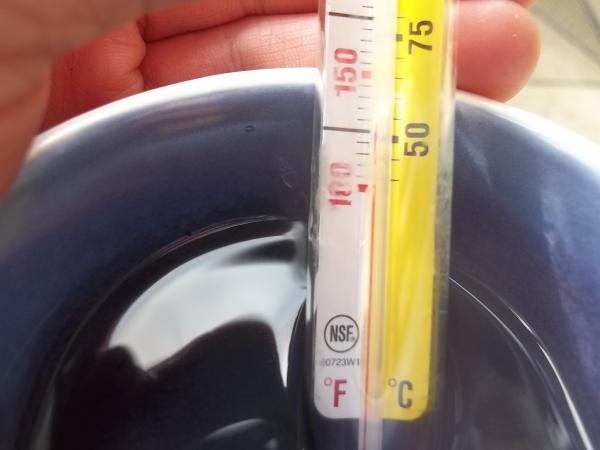I had to burn some papers today and it dawned on me if I could actually boil water in a plastic soda bottle like I’d seen in various videos?
As luck would have it, I had an empty soda bottle and so I gave it a shot.
I strung up the bottle about two-thirds full of cold water like this with the cap removed:

I didn’t want to get the bottle too close to the fire (the fire was just getting going in the photo above) because I worried that the bottom of the bottle would melt. As it turns out, I should have got the bottle a lot closer.
Only several minutes in it was obvious that some bubbles were forming on the sides of the bottle which was encouraging:

I decided to pour out a little bit and test for hotness. It was slightly warm but nothing to get excited about. Several minutes later I noticed the neck of the bottle was beginning to deform quite a bit:

After a good thirty minutes hanging over a decent, albeit relatively small, fire I decided to call it quits because it was starting to sprinkle and I didn’t want to spend all day messing with this.
So, I checked the temperature with a candy thermometer and saw it reached about 135 degrees Fahrenheit (it shows a bit lower by the time I snapped the photo). I know it’s hard to see but the red bar reaches just above the difference between 100 and 150:

Though encouraging, this wasn’t quite as easy as I’d hoped for or expected. I’m afraid I would have to give this quite a long time over a good fire and maybe even to lower the soda bottle even closer to the fire.
The good news is that the bottom of the bottle was still well formed but the bottle overall was a bit deformed to say the least:

If this is something I had to rely upon to ensure my water was pasteurized I would have been hard-pressed to make it a reality. I’d say that if I really HAD to get it done I could have but to actually bring the water to a boil? Well, according to the following video it’s possible:
Which brings me back to the point where my design wasn’t going to work well at all… I should have actually placed the bottle on embers instead. Perhaps I’ll try that next time.
Of course, I wouldn’t absolutely need to boil the water; I’d simply need to get the water to reach a high enough temperature to kill pathogens and for long enough and that would have sufficed.
According to this reference I was close:
| 63ºC (145ºF) | 30 minutes | Vat Pasteurization |
| 72ºC (161ºF) | 15 seconds | High temperature short time Pasteurization (HTST) |
| 89ºC (191ºF) | 1.0 second | Higher-Heat Shorter Time (HHST) |
| 90ºC (194ºF) | 0.5 seconds | Higher-Heat Shorter Time (HHST) |
| 94ºC (201ºF) | 0.1 seconds | Higher-Heat Shorter Time (HHST) |
| 96ºC (204ºF) | 0.05 seconds | Higher-Heat Shorter Time (HHST) |
| 100ºC (212ºF) | 0.01 seconds | Higher-Heat Shorter Time (HHST) |
| 138ºC (280ºF) | 2.0 seconds | Ultra Pasteurization (UP) |
Another ten degrees and I was in business.
The moral of the story?
Watch somebody else do it first… then do what they did. 😉
Leave a Reply